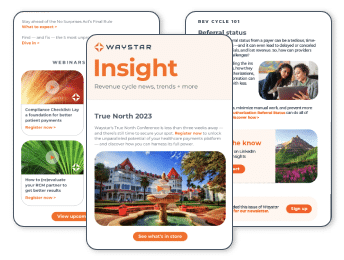Is DRG accuracy a key focus for your team? If not, it should be. Here’s why:
The Centers for Medicare & Medicaid Services created diagnosis-related groups (DRG) to encourage efficient care and cost containment and remove incentives to over-treat patients. Despite being rolled out in the early 1980s, many hospitals and health systems are still losing revenue to DRG-related oversight. The national benchmark for DRG assignment accuracy fell to 72% in 2018; according to a recent survey of hospital finance leaders, 68% of respondents don’t think their solutions are equipped to manage DRG coding.[1]
A DRG covers all charges associated with an inpatient visit — from admission to the point of payment. Documenting the patient journey and assigning proper DRG classifications and relative weights, which are adjusted on an annual basis, requires effective communication between clinical and revenue cycle teams.[2] An incorrect DRG, whether it omits a comorbidity or doesn’t account for a secondary diagnosis, can cost a facility thousands of dollars in unrealized revenue. And when you consider that U.S. hospitals are experiencing decreased operating margins (down 39% between 2015 and 2017) there’s just no room for DRG errors.
Let’s look at a common example. Many hospitals must keep a respiratory therapist on the clock if an admitted patient has a comorbidity of asthma — even if the patient didn’t need respiratory care during the course of their stay. But, higher-paying DRGs like this are often overlooked, and hospitals aren’t paid as they should be.
Here’s our advice on how to maximize reimbursement when working within the DRG framework.
1. Deploy technology that reliably uncovers DRG errors
Ensuring DRG assignments accurately reflect the care that was delivered—and all the resources that were used—during an inpatient visit can be time- and labor-intensive work, but it’s critical to avoiding revenue leakage. The good news: technology can take much of this burden off of your team. The best of these solutions take a multi-faceted approach to DRG analysis, leveraging machine learning and predictive analytics, benchmarking and cross-source data comparison, and best practice rules to automatically flag potential DRG anomalies or errors. Many of these technologies also give you the ability to seamlessly route flagged claims with detailed notes for resolution.
2. Tap into root cause analysis
Having the ability to determine the root cause of a DRG issue can help you address revenue leakage at the source to avoid systematic, ongoing errors. Better tech allows providers to easily slice and dice DRG-related data and generate reports on demand. This leads to quicker, more informed decisions, better prevention strategies, and ultimately more revenue down the line.
We hope this piece has illuminated a few ways to improve your DRG workflows and capitalize on more revenue. For more on common cause of charge capture leakage and how to stem lost revenue with better tech, check out our revenue integrity whitepaper.
Looking for more strategies to strengthen revenue streams? Check out Waystar’s resource library and see how the best and brightest in healthcare are approaching RCM.


